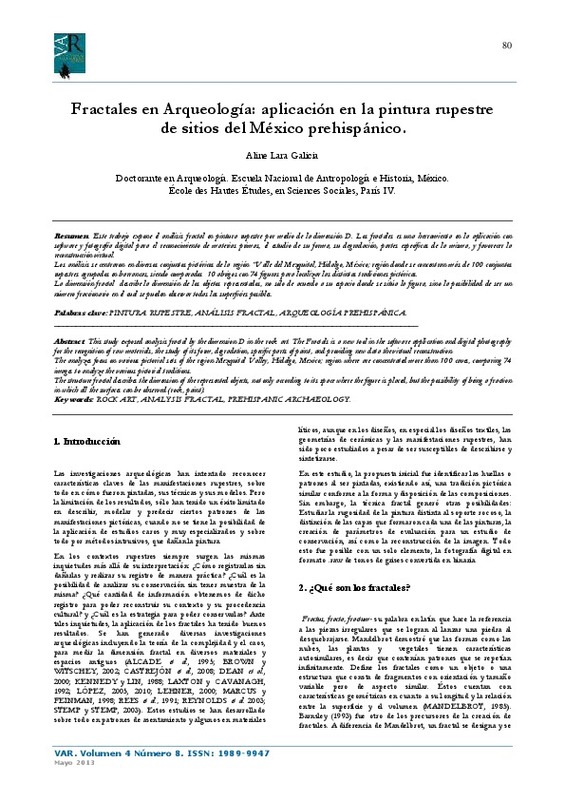RODRÍGUEZ, A., ALONSO, C. & VELÁZQUEZ J. (1995): "Fractales para la arqueología: un nuevo lenguaje", Trabajos de prehistoria, vol. 52, nº 1, pp. 13-24.
BROWN, Clifford et al. (2002): "The fractal geometry of ancient maya settlement." Journal of archaeological science, nº 30. Estados Unidos, pp. 1619-1632.
DEAN Jeffrey, et al. (2000): "Understanding anasazi culture through agent-based modeling" ,Dynamics in human and primate societies, Timothy Kohler y George Gumerman (compiladores), Oxford, Oxford University Press, pp. 179-205.
[+]
RODRÍGUEZ, A., ALONSO, C. & VELÁZQUEZ J. (1995): "Fractales para la arqueología: un nuevo lenguaje", Trabajos de prehistoria, vol. 52, nº 1, pp. 13-24.
BROWN, Clifford et al. (2002): "The fractal geometry of ancient maya settlement." Journal of archaeological science, nº 30. Estados Unidos, pp. 1619-1632.
DEAN Jeffrey, et al. (2000): "Understanding anasazi culture through agent-based modeling" ,Dynamics in human and primate societies, Timothy Kohler y George Gumerman (compiladores), Oxford, Oxford University Press, pp. 179-205.
KENNEDY, Stephen & LIN, Wei- Hsiung (1988): "A fractal technique for the classification of projectile point shapes", Estados Unidos, Geoarchaeology, nº 3, vol. 4, pp. 297-301.
LARA, Aline (2010): "Estado del arte en las manifestaciones rupestres del Valle del Mezquital", PEH, NMAM, AE H, pp.145-173.
LARA, Aline (2012): Las firmas fractales en las manifestaciones rupestres del Valle del Mezquital, México, Tesis de doctorado, Escuela Nacional de Antropología e Historia.
LAXTON, R. R. & CAVANAGH W. G. (1992): "The Rank-Size Dimension and the History of Site Structure from Survey Data", en Journal of quantitative anthropology, vol. 5, pp. 327-358.
MANDELBROT, Benoit B (1985): "Self-Affine Fractals and Fractal Dimension", en Physica Scripta, vol. 32, nº 4.
MARCUS Joyce y FEINMAN Gary (1998): "Introduction", Archaic states, Gary Feinman y Joyce Marcus (eds.), Estados Unidos, pp. 3-13.
PARROT François (2009): Fractal researches on geosciences, México, UNAM.
REES Anna, et al. (1991): "An investigation of the fractal properties of flint microwear images", Journal of archaeological science, v. 18, pp. 629-640. http://dx.doi.org/10.1016/0305-4403(91)90026-L
REYNOLDS, Robert et al. (2003): "The effects of generalized reciprocal exchange on the resilience of social networks: An example from the prehispanic mesa verde region". Computational & mathematical organization theory, nº 9, pp. 227-254. http://dx.doi.org/10.1023/B:CMOT.0000026583.03782.60
SCHLOEN, David (2001): The house of the father as fact and symbol: patrimonialism in ugarit and the ancient near east, Studies in the archaeology and history of the Levant 2, Eisenbrauns, pp. 414.
STEMP James y Michael Stemp (2003): "Documenting stages of polish development on experimental stone tools: surface characterization by fractal geometry using UBM laser profilometry", Journal of archaeological science, vol. 30, Academic Press, pp. 287-296.
[-]








